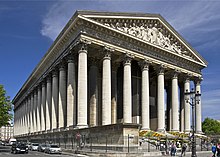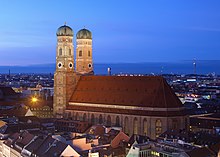Church (building)



A church building, often simply called a church, is a building used for Christian religious activities, particularly for worship services. The term in its architectural sense is most often used by Christians to refer to their religious buildings, but it is sometimes used (by analogy) to refer to buildings of other religions.[1] In traditional Christian architecture, the church is often arranged in the shape of a Christian cross. When viewed from plan view the longest part of a cross is represented by the aisle and the junction of the cross is located at the altar area.
Towers or domes are often added with the intention of directing the eye of the viewer towards the heavens and inspiring church visitors. Modern church buildings have a variety of architectural styles and layouts; many buildings that were designed for other purposes have now been converted for church use; and, similarly, many original church buildings have been put to other uses.
The earliest identified Christian church was a house church founded between 233 and 256. From the 11th through the 14th centuries, a wave of building of cathedrals and smaller parish churches occurred across Western Europe. A cathedral is a church, usually Roman Catholic, Anglican, Oriental Orthodox or Eastern Orthodox, housing the seat of a bishop.
Etymology
In Greek, the adjective kyriak-ós/-ē/-ón means "belonging, or pertaining, to a Kyrios" ("Lord"), and the usage was adopted by early Christians of the Eastern Mediterranean with regard to anything pertaining to the Lord Jesus Christ: hence "Kyriakós oíkos" ("house of the Lord", church), "Kyriakē" ("[the day] of the Lord", i.e. Sunday), or "Kyriakē proseukhē" (the "Lord's Prayer").[2]
In standard Greek usage, the older word "ecclesia" (ἐκκλησία, ekklesía, literally "assembly", "congregation", or the place where such a gathering occurs) was retained to signify both a specific edifice of Christian worship (a "church"), and the overall community of the faithful (the "Church"). This usage was also retained in Latin and the languages derived from Latin (e.g. French église, Italian chiesa, Spanish iglesia, Portuguese igreja, etc.), as well as in the Celtic languages (Welsh eglwys, Irish eaglais, Breton iliz, etc.) and in Turkish (kilise).[2]
In the Germanic and some Slavic languages, the word kyriak-ós/-ē/-ón was adopted instead and derivatives formed thereof. In Old English the sequence of derivation started as "cirice" (Ki-ri-keh), then "churche" (kerke), and eventually "church" in its current pronunciation. German Kirche, Scots kirk, Russian церковь (tserkov), etc., are all similarly derived.[3]
History
Antiquity
According to the New Testament, the earliest Christians did not build church buildings. Instead, they gathered in homes (Acts 17:5, 20:20, 1 Corinthians 16:19) or in Jewish worship places like the Second Temple or synagogues (Acts 2:46, 19:8). The earliest archeologically identified Christian church is a house church (domus ecclesiae), the Dura-Europos church, founded between 233 and 256.[4] In the second half of the 3rd century CE, the first purpose-built halls for Christian worship (aula ecclesiae) began to be constructed. Although many of these were destroyed early in the next century during the Diocletianic Persecution, even larger and more elaborate church buildings began to appear during the reign of the Emperor Constantine the Great.[5]
Medieval times

From the 11th through the 14th centuries, a wave of building of cathedrals and smaller parish churches occurred across Western Europe. In addition to being a place of worship, the cathedral or the parish church was used by the community in other ways. It could serve as a meeting place for guilds or a hall for banquets. Mystery plays were sometimes performed in cathedrals, and cathedrals might also be used for fairs. The church could be used as a place to thresh and store grain.[6]
Architecture
A common architecture for churches is the shape of a cross (a long central rectangle, with side rectangles, and a rectangle in front for the altar space or sanctuary). These churches also often have a dome or other large vaulted space in the interior to represent or draw attention to the heavens. Other common shapes for churches include a circle, to represent eternity, or an octagon or similar star shape, to represent the church's bringing light to the world. Another common feature is the spire, a tall tower on the "west" end of the church or over the crossing.

Types
Basilica
The Latin word basilica (derived from Greek, Basiliké Stoà, Royal Stoa) was originally used to describe a Roman public building (as in Greece, mainly a tribunal), usually located in the forum of a Roman town.[7][8]
After the Roman Empire became officially Christian, the term came by extension to refer to a large and important church that has been given special ceremonial rights by the Pope. Thus the word retains two senses today, one architectural and the other ecclesiastical.

Cathedral

A cathedral is a church, usually Roman Catholic, Anglican, Oriental Orthodox or Eastern Orthodox, housing the seat of a bishop. The word cathedral takes its name from cathedra, or Bishop's Throne (In Template:Lang-la). The term is sometimes (improperly) used to refer to any church of great size.
A church that has the function of cathedral is not necessarily a large building. It might be as small as Christ Church Cathedral in Oxford, England, Sacred Heart Cathedral in Raleigh, United States, or Chur Cathedral in Switzerland. However, frequently, the cathedral along with some of the abbey churches, was the largest building in any region.
Alternative buildings
Old and disused church buildings can be seen as an interesting proposition for developers as the architecture and location often provide for attractive homes[9][10] or city centre entertainment venues[11] On the other hand, many newer churches have decided to host meetings in public buildings such as schools,[12] universities,[13] cinemas[14] or theatres.[15]
There is another trend to convert old buildings for worship rather than face the construction costs and planning difficulties of a new build. Unusual venues in the UK include an old Tram power station,[16] a former bus garage,[17] an old cinema and bingo hall,[18] a former Territorial Army Drill Hall,[19] and a former synagogue.[20] A windmill has also been converted into a church at Reigate Heath.
There has been an increase in partnerships between church management and private real estate companies to redevelop church properties into mixed uses. While it has garnered criticism from some, the partnership offers congregations the opportunity to increase revenue while preserving the property.[21]
See also
- Architecture of cathedrals and great churches
- Architecture of the medieval cathedrals of England
- Cathedral floorplan
- Chapel
- Cowboy church
- Duomo
- Eastern Orthodox church architecture
- House church
- List of basilicas
- Lists of cathedrals
- List of highest church naves
- List of largest church buildings in the world
- List of oldest church buildings
- List of tallest church buildings in the world
- List of Unitarian, Universalist, and Unitarian Universalist churches
- Mandir
- Meeting house
- Monastery
- Mosque
- Palisade church
- Place of worship
- Post church
- Pub church
- Polish Cathedral style
- Shrine
- Simultaneum
- Stave church
- Synagogue
- Temple
References
- ^ Use of the term "The Manichaean Church", Encyclopædia Britannica
- ^ a b "Church". Online Etymology Dictionary. Retrieved 8 August 2016.
- ^ "THE CORRECT MEANING OF "CHURCH" AND "ECCLESIA"". www.aggressivechristianity.net. Retrieved 22 June 2016.
- ^ Snyder, Graydon F. (2003). Ante Pacem: Archaeological Evidence of Church Life Before Constantine. Mercer University Press. p. 128.
- ^ Hartog, Paul (ed.). The Contemporary Church and the Early Church: Case Studies in Ressourcement. Pickwick Publications. ISBN 978-1606088999. (Chapter 3)
- ^ Levy. Cathedrals and the Church. p. 12.
- ^ The Oxford Dictionary of Christian Art and Architecture (2013 ISBN 978-0-19968027-6), p. 117
- ^ "The Institute for Sacred Architecture - Articles- The Eschatological Dimension of Church Architecture".
- ^ Alexander, Lucy (14 December 2007). "Church conversions". The Times. London. Retrieved 30 April 2010.
- ^ "Buying a church conversion". OurProperty.co.uk. Retrieved 18 October 2011.
- ^ Site design and technology by Lightmaker.com. "quality food and drink". Pitcher and Piano. Retrieved 18 October 2011.
- ^ "Welcome to the Family Church Christchurch Dorset". The Family Church Christchurch. Retrieved 18 October 2011.
- ^ "Welcome to The Hope Church, Manchester... A Newfrontiers Church based in Salford, Greater Manchester UK". The-hope.org.uk. Retrieved 18 October 2011.
- ^ "Jubilee Church London". jubileechurchlondon.org.
- ^ "Welcome to Hillsong Church". Hillsong Church UK. Retrieved 25 November 2016.
- ^ "CITY CHURCH NEWCASTLE & GATESHEAD – enjoying God...making friends...changing lives – Welcome". City-church.co.uk. Retrieved 18 October 2011.
- ^ "Aylsham Community Church". Aylsham Community Church. Retrieved 18 October 2011.
- ^ Hall, Reg (2004). Things are different now: A short history of Winchester Family Church. Winchester: Winchester Family Church. p. 11.
- ^ "ABOUT". www.barnabascommunitychurch.com. Retrieved 5 December 2016.
- ^ "Where We Meet". City Church Sheffield. Retrieved 5 December 2016.
- ^ Friedman, Robyn A. "Churches Redeveloping Properties to Give Them New Life". Wall Street Journal. ISSN 0099-9660. Retrieved 23 October 2015.
Bibliography
- Levy, Patricia (2004). Cathedrals and the Church. Medieval World. North Mankato, MN: Smart Apple Media. ISBN 1-58340-572-0.
- Krieger, Herman (1998). Churches ad hoc. PhotoZone Press.
- Erlande-Brandenburg, Alain, Qu'est-ce qu'une église ?, Gallimard, Paris, 333 p., 2010.
- Gendry Mickael, L’église, un héritage de Rome, Essai sur les principes et méthodes de l’architecture chrétienne, Religions et Spiritualité, collection Beaux-Arts architecture religion, édition Harmattan 2009, 267 p.
External links
- New Advent Catholic Encyclopedia – Ecclesiastical Buildings
- New Advent Catholic Encyclopedia – The Church
- Prairie Churches Documentary produced by Prairie Public Television
- Iowa Places of Worship Documentary produced by Iowa Public Television
- Herbermann, Charles, ed. (1913). . Catholic Encyclopedia. New York: Robert Appleton Company.
